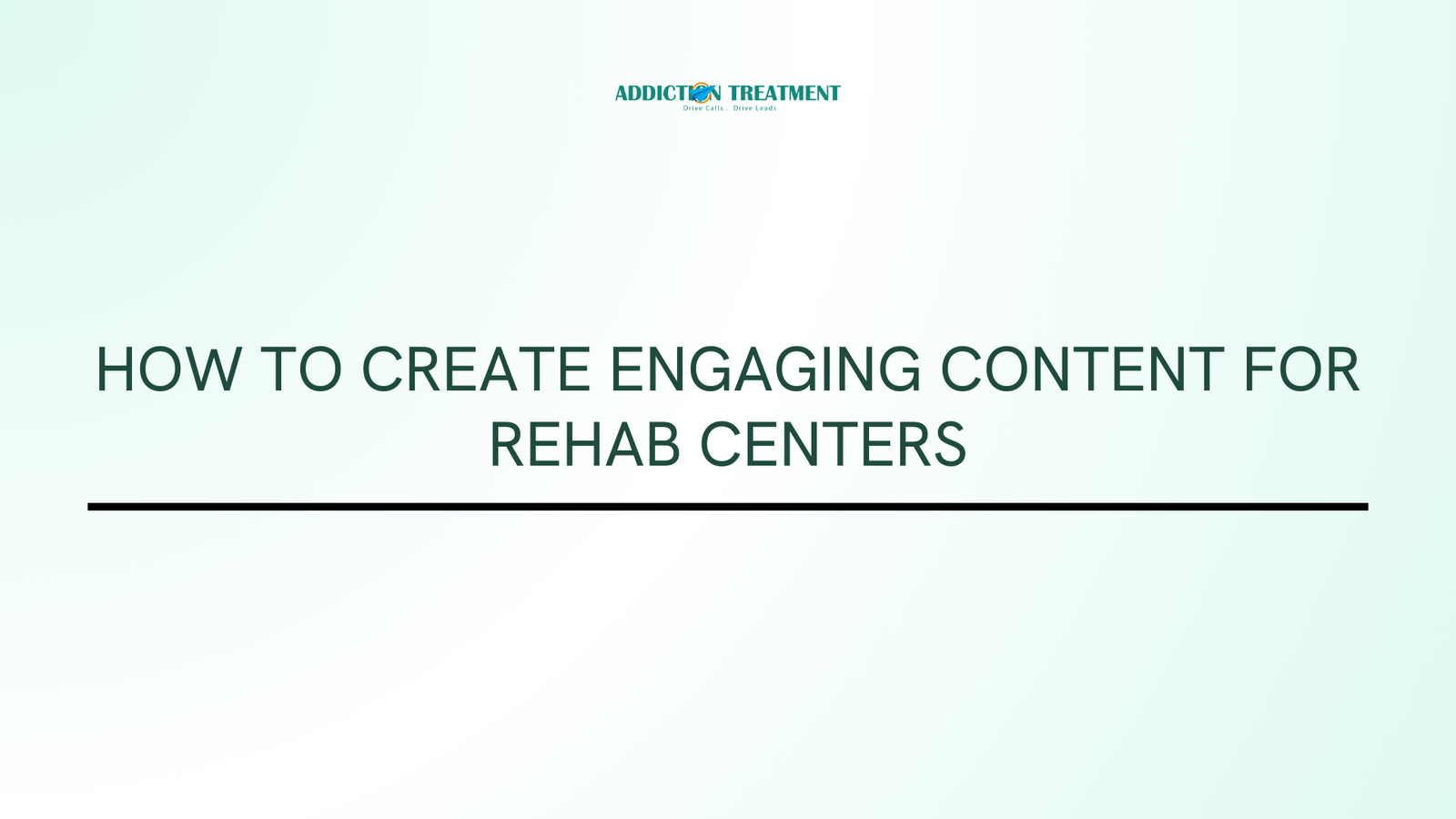In today’s digital world, rehab centers must go beyond traditional advertising to connect with potential clients and their families. Engaging content serves as a bridge between your services and the people seeking help. By offering valuable, empathetic, and informative content, you can establish trust, build authority, and guide individuals toward taking the first step toward recovery.
This article outlines effective strategies for creating engaging content for rehab centers, focusing on techniques to educate, inspire, and convert your audience into patients or advocates for your services.
Why Engaging Content Matters for Rehab Centers
1. Builds Trust
People seeking addiction treatment are often vulnerable and cautious. High-quality content that provides answers and support helps build trust in your center as a reliable resource.
2. Increases Online Visibility
Search engines prioritize engaging, informative, and optimized content. This boosts your center’s visibility, ensuring you’re found by those actively searching for help.
3. Encourages Action
Well-crafted content motivates potential clients or their families to reach out for more information, book consultations, or share your resources with others.
Key Elements of Engaging Content for Rehab Centers
1. Empathy and Understanding
Your audience is often navigating a difficult time. Use language that is compassionate, non-judgmental, and supportive.
- Example: Instead of “Overcome Your Addiction,” use “Take the First Step Toward Recovery.”
2. Educational Value
People often search for information about addiction, recovery options, and treatment processes. Providing detailed, easy-to-understand answers makes your content more valuable.
- Example Topics:
- “What to Expect During Inpatient Rehab”
- “Understanding the Different Types of Addiction Treatment Programs”
3. Actionable Advice
Content that includes actionable steps can empower readers to make decisions or changes.
- Example: “5 Ways to Support a Loved One in Recovery” provides practical tips for family members.
4. Visual Appeal
Visual elements such as videos, infographics, and photos make content more engaging and digestible.
- Example: Use an infographic to explain the stages of recovery or the benefits of detox programs.
5. Optimized for SEO
Search engine optimization ensures your content reaches the right audience.
- Best Practices:
- Include relevant keywords like “affordable rehab centers,” “detox programs near me,” or “addiction recovery tips.”
- Optimize headings, meta descriptions, and image alt tags.
Types of Engaging Content for Rehab Centers
1. Blog Posts
Blogs are a versatile way to provide in-depth information on topics that matter to your audience.
- Example Topics:
- “How to Choose the Right Rehab Center for Your Needs”
- “10 Signs You May Need Addiction Treatment”
- “The Benefits of Holistic Recovery Programs”
2. Video Content
Videos are one of the most engaging forms of content, offering a personal and relatable way to connect with your audience.
- Examples:
- Facility tours to showcase your amenities.
- Testimonials from former patients sharing their recovery journey.
- Educational videos explaining the rehab process.
3. Infographics
Infographics condense complex information into visually appealing and easy-to-understand graphics.
- Example Topics:
- The stages of addiction recovery.
- Statistics on addiction and recovery success rates.
- A comparison of inpatient vs. outpatient treatment.
4. Success Stories
Sharing real-life success stories humanizes your center and inspires hope in potential clients.
- Format Ideas:
- Written testimonials with quotes.
- Video interviews with patients (with consent).
- Anonymous case studies highlighting results.
5. Downloadable Resources
Offering free resources in exchange for contact information helps generate leads while providing value.
- Examples:
- “The Ultimate Guide to Addiction Recovery.”
- Checklists for preparing for rehab.
- Family support guides.
6. Social Media Posts
Social media platforms allow you to reach a broad audience and engage in conversations about addiction and recovery.
- Examples:
- Inspirational quotes or messages.
- Quick tips for staying on the path to recovery.
- Links to blog posts or videos.
Steps to Create Engaging Content for Rehab Centers
1. Understand Your Audience
Identify the needs, concerns, and preferences of your target audience, including potential clients, families, and referral partners.
- Audience Segments:
- Individuals seeking treatment.
- Families looking for resources to help a loved one.
- Professionals like therapists or doctors referring patients.
2. Focus on Empathy and Authenticity
Content should reflect genuine care and understanding for your audience’s struggles.
- Avoid: Overly promotional language or promises of “quick fixes.”
- Use: Honest, supportive messaging that emphasizes your center’s role in the recovery journey.
3. Incorporate SEO Best Practices
SEO ensures your content appears in search results for relevant queries.
- Tips:
- Conduct keyword research to identify terms your audience searches for.
- Use keywords naturally in your content.
- Ensure your website is mobile-friendly and loads quickly.
4. Leverage Multimedia
Incorporate videos, images, and infographics to make your content visually engaging and shareable.
- Example: A video featuring your staff explaining what sets your center apart.
5. Include Clear Calls-to-Action (CTAs)
Encourage readers to take the next step, whether it’s contacting your center, downloading a resource, or booking a consultation.
- Examples:
- “Contact us today to learn more about our treatment programs.”
- “Download our free recovery guide to get started.”
Promoting Your Content Effectively
1. Share on Social Media
Post your content on platforms like Facebook, LinkedIn, and Instagram to increase visibility and engagement.
2. Use Email Marketing
Include new blog posts, videos, or resources in your email campaigns to nurture leads and stay top of mind.
3. Collaborate with Partners
Work with referral partners, such as therapists or community organizations, to share your content with their networks.
4. Invest in Paid Promotion
Boost your top-performing content using Google Ads or social media ads to reach a larger audience.
Measuring the Success of Your Content
Track these metrics to evaluate the effectiveness of your content strategy:
- Traffic: Monitor website visits generated by your content.
- Engagement: Analyze time spent on pages, social shares, and comments.
- Lead Generation: Measure how many readers convert into leads through contact forms or downloads.
- SEO Performance: Use tools like Google Analytics to track rankings for target keywords.
Overcoming Challenges in Content Creation
1. Maintaining Consistency
Publishing consistently can be challenging without a clear plan.
Solution: Create a content calendar and prioritize high-impact topics.
2. Balancing SEO and Authenticity
Overemphasis on SEO can make content feel robotic or forced.
Solution: Write for humans first, then optimize for search engines.
3. Addressing Sensitive Topics
Navigating the emotional aspects of addiction can be difficult.
Solution: Use compassionate language and avoid sensationalism.
Conclusion
Engaging content is a powerful tool for rehab centers to connect with their audience, build trust, and drive inquiries. By focusing on empathy, educational value, and SEO optimization, you can create content that resonates with potential clients and their families. With the right strategies in place, your content can become a key driver of growth, helping individuals find the support they need on their journey to recovery.


Leave a Reply